
http://www.indotalisman.com/handsymb.html
 THE SIGN OF DISTRESS. top left: the ukranian president made this gesture after calls for his resignation (27 march 09). Next the president of Libanon during the 2006 war when he was fearing a coup against him (8 dec. 2006).
THE SIGN OF DISTRESS. top left: the ukranian president made this gesture after calls for his resignation (27 march 09). Next the president of Libanon during the 2006 war when he was fearing a coup against him (8 dec. 2006).Middle: the three positions of the masonic sign of distress (Scotch Rite Masonry Illustrated vol.2. Bottom left: detail of the Transfiguration by Fran Angelico. Next is Quetzalcoatl and finally the egyptian goddess of the dead, all showing the sign of distress
 The sign of "Heaven and Earth" is often associated with the theme of ressurection or with deities sent to earth for a special mission, like Buddah, Christ, Quetzalcoatl etc
The sign of "Heaven and Earth" is often associated with the theme of ressurection or with deities sent to earth for a special mission, like Buddah, Christ, Quetzalcoatl etcThe most prominent feature of the art productions of the Initiates of the Mystery Schools were the hand signs and this was known as the Ancient Sign Language which was transmitted from Age to Age, culture to culture. J.S.M. Ward made a thorough study of this secret sign language and in his book, "The Sign Language of the Mysteries," he identifies several of these hand signs and gestures to be found mostly in Christian art although by no means limited to Christendom. In his book Ward offers many instances of each sign. He explains that these hand poses are to be found all over Europe, Africa, Asia, India, Oceania, the Americas, ancient Crete, Polynesia, Babylonia, etc., in short, all over the world. Among the hand signs that he discusses are:
- Sign of Preservation
- Sign of Faith
- Sign of Distress/Surrender
- Sign of Death
- Sign of Praise
- Sign of the Heart
- Sign of Prayer
- Sign of Benediction or Blessing
- Sign of Secrecy
- Sign of Destruction
- Sign of Exultation
- Sign of Reverence
- Sign of Horror
- Sign or Resignation
- Sign of Sacrifice
- Sign of Heaven and Earth
- Sign of Despair/Regret
- The vesica pisces sign
- Sign of completion
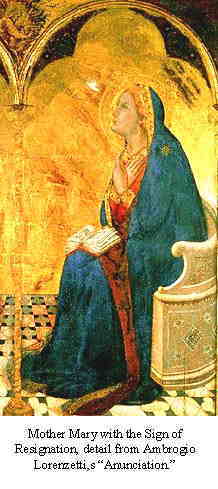 | 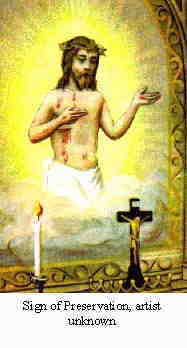 |
Sign of Preservation
There are many variations of this sign. Basically, it is posed by placing one hand over the heart and raising the other at an angle at the elbow with the hand pointing upwards. In some forms, it is the index finger that points skyward. In most depictions of this sign it is the left hand rather than the right that is raised. There are numerous instances of this pose in Egyptian art. The Egyptologist, E.A. Wallis Budge, interprets the hieroglyph with this sign as Hen, or "praise." The god Anubis is often represented with this hand posture, and murals in the palaces and tombs of the pharaohs often illustrate votaries of Ra with this significant gesture. This sign is also found in the Minoan and Mycenaen civilizations. In Christian art, Jesus is often portrayed assuming many occult hand signs, among these is the Sign of Preservation. The sun god Damuzi of the Babylonians while descending into the underworld likewise bears this sign, as depicted on certain objects. In his book mentioned previously, J.S.M. Ward tells of a Roman sarcophagus in the Bardo Museum, Tunis, showing the emergence of Jonah from the whale that swallowed him for three days, and making the Sign of Preservation--in effect, indicating that his life was saved. Among the mystical Islamic sects, the Whirling Dervishes appropriate the use of this important hand pose in their ceremonial rites and practices. In archaic times, the Sign of Preservation was adopted by those petitioning the deity for the preservation of oneself or someone else, and 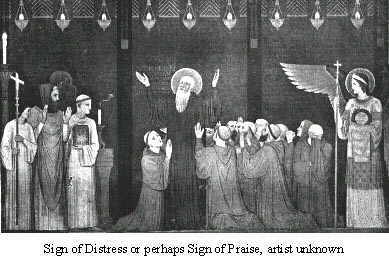 with the strong conviction that the request was granted. In contradistinction to this, it was also employed by those of high spiritual attainment assuring others of their salvation. In Christianity it is often associated with the Second Person of the Holy Trinity.
with the strong conviction that the request was granted. In contradistinction to this, it was also employed by those of high spiritual attainment assuring others of their salvation. In Christianity it is often associated with the Second Person of the Holy Trinity.
Sign of Faith
This sign resembles the Sign of Preservation with the exception that the hand pointing upwards is not squared at an angle and not pointing to the sky. It points outwards away from the body. Like the above sign, many examples of these are to be found distributed all over the world.
Sign of Distress/Surrender
When the two hands are lifted upwards above the head with the elbows bent--this is known as the Sign of Distress. This is one of those universal hand signs, and it seems almost human nature to fling the hands into the air when in despair or when faced with overwhelming pressure as a sign of psychological turmoil and the "giving-in" to a certain situation, or when feeling helpless. Therefore, it is not surprising when we find the use of this sign all around the globe as depicted in artistic works, and experientially in everyday life. This sign is an appeal for aid and is universal like many of the other signs mentioned in this section. Its use can be traced as early as 3,000 B.C. Quetzalcoatl, one of the gods of the Mayans, is sometimes depicted 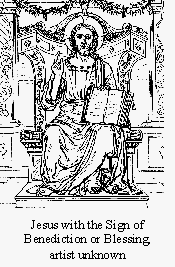 with this hand pose.
with this hand pose.
Sign of Death
This hand sign is related to the throat chakra, or psychic center. It consists of placing the hand's edge-whether left or right hand-at the throat. The thumb points directly at the throat itself. It is actually a moving gesture and is effected by moving the hand's edge across the throat as if to cut it. This sign suggests that something is to be terminated or killed, or that it is already dead. The ancient Romans and Egyptians were well familiar with this sign and in some Christian paintings of the crucifixion, the disciple John the Beloved is portrayed with this sign of cutting the throat while standing before the crucified Jesus. Arabs and Sudanese make use of this sign to swear their innocence uttering that God should cut their throats should they be telling a falsehood. Several American Indian tribes employ this sign as a salutation meaning that they are "faithful or true unto death."
Sign of Praise
This sign is similar to the Sign of Distress except that the hands are not lifted above the head but extended forward in front of the body, inclining upwards with the hands facing outwards and the elbows bent. This is also a greeting sign and the initial start of the salaam gesture of the Arabs. 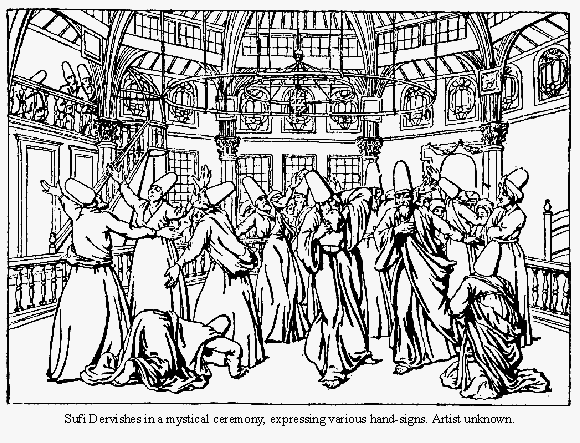
Sign of the Heart
This sign is accomplished by placing the hand over the heart. A survival of this gesture in modern times is the bowing of a gentlemen to a lady with his hand to his heart as a salutation of respect, or as it was customary in the 17th and 18th century in Europe, for a man to remove his hat and to place it at the heart region when greeting the opposite sex. This is a hoary sign. It is to be found in ancient Egypt, Rome, and even in Crete in the Minoan period. It is also to be seen in the mosaic art of the many old churches and cathedrals. The meaning of this sign is a little obscure. It has been suggested that it signify faith or fidelity. However, with the placement of the hand at the heart we may make a conjecture and say that it concerns the finer sentiments of a person conveyed to the object of his attention or affection.
Sign of Prayer
This is probably the best known of ecclesiastical signs which is also used by the lay person. It consists of placing the palms of the hands together with the fingertips pointing in an upward direction. Another Sign of Prayer is the folding of the hands together intertwining the fingers. 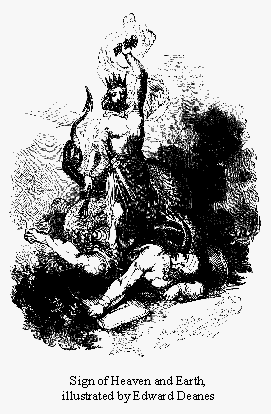
Sign of Benediction or Blessing
In Christianity, this sign is utilized mainly by the priesthood. It is used by priests to bless people and consecrate objects. To assume this sign, the third and fourth fingers are folded onto the palms with the index and middle fingers held upright. The thumb may also be erect or it may be folded upon the ring finger. The significance of the erect thumb and first two fingers in the act of blessing is that the grace, virtue, and power of the Holy Trinity are being conveyed. Occultly, the subtle energies flowing from the hands are stronger at the terminal points of these digits than they are at the ring and little fingers.
Sign of Secrecy
This is a sign that has survived to contemporary times and can continually be seen in everyday life. It probably originated in Egypt during the heydays of the Mystery Schools. This sign was associated with Horus, or Harpocrates--one of the forms of Horus. This sign is executed by putting a finger to the lips as though to seal it. Its significance is that of secrecy and silence. In the Mystery Schools the Initiates were pledged to a vow of secrecy, never revealing the secrets of the Temple unless authorized to do so. Even nowadays, the following injunction may be found in occult schools: "know, dare, do, and be silent."
Sign of Destruction
When one or both of the hands are seen on the solar plexus in religious art, it signifies destruction. We can understand the significance of this sign when viewed from a metaphysical point of view. The solar plexus chakra is a storehouse of potent energies that may be used for good or ill. When this center is awakened prematurely in a disciple's life, it may cause problems that the disciple is not equipped as yet to handle. Physical, physiological, and psychological--not to mention karmic difficulties--might arise when a disciple foolishly stimulates this center. The solar plexus chakra is an emotional focus and by being polarized at this level one may have trouble extricating oneself from the lower instinctive and egoistic nature. The disciple may be destroyed by this center and evolutionary progress postponed, thus the hand gesture on the solar plexus came to be associated with destruction. There are numerous examples of the Sign of Destruction in Art. In India, Shiva, the Destroyer is often depicted with this gesture. Many Greek and Christian art-forms also bear personages with this sign.
Sign of Exultation
This hand pose is a sign of joy and satisfaction; it is done by extending the hands above the head with the fingertips of the hands touching. Though not as numerous as some of the other signs, there are several examples of these in Christian art. In China, the Hung Society uses this sign to represent the metal element. 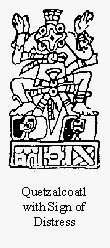
Sign of Reverence
Reverence in the sign language of the Mysteries, is indicated by the shading of one's eyes with the hand, whether left or right. In some variations of this sign the eyes are fully covered. This sign originated in cultures where it was impolite to look directly at one's superior; for instance, a soldier would make this sign when saluting a superior officer. Another possible origin of this sign is the experiences had by blessed individuals during angelic visitations. The presence of these spiritual beings compels the beholder to shield their eyes from the angelic radiance. This hand gesture is not unique to any race for it is to be found distributed all over the world--in Ceylon, Australia, Africa, Asia, and Europe.
Sign of Horror
One of the dramatic signs, the gesture of horror is made by extending the right hand, palm outwards, while the head is turned to the right as though refusing to see something objectionable or frightening. The left hand is this gesture point outwards and in a downward direction as if trying to expel something. Examples of this sign in art may be seen in the Vatican and in the British Museum. 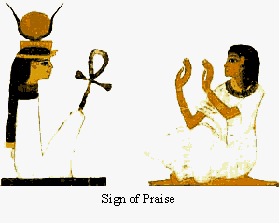
Sign or Resignation
This sign consists in crossing the arms upon the chest with the fingertips of the right hand on the left shoulder and the fingertips of the left hand on the right shoulders. This gesture is sometimes portrayed with the right hand over the left, but the reverse is regarded as a more proper representation according to tradition. This is another one of those signs that may have originated in the Mystery Schools of Egypt. The god Osiris and the statues representing Egyptian pharaohs are often depicted in this pose by artisans. For some specific reason the Egyptians also buried their dead in this manner, with the hands of the mummy crossed upon their breast. Even the sarcophagi or mummy cases of the deceased bear a pictorial resemblance of them with the same sign. In the Renaissance, artists often depicted Mother Mary with such a hand pose. Like the many hand gestures described herein, the Sign of Resignation generates a certain occult power of which we shall discuss later in an upcoming article when we apply and incorporate the sign in our mudra practices. The occult function of a sign is just as important as its esoteric meaning, perhaps even more so. 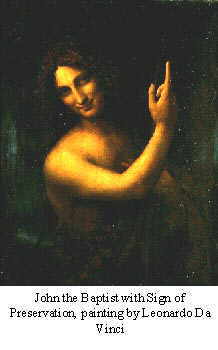
Sign of Heaven and Earth
This sign is executed by extending one hand above the head pointing skywards, and the other extended downwards pointing to the earth. According to Ward, the significance of this sign in Christianity is that someone had descended to Earth and later re-ascended to Heaven. Or alternatively, ascended to Heaven and later descended to Earth. There are numerous examples of this sign in Christian art related to the raising of Lazarus, the descent of Jesus into Hell to save the inhabitants, and Jesus' resurrection. There are many variations of this sign. Sometimes the hand with its open palm pointing upwards has its fingers together; occasionally we find examples where the index finger points upwards while the rest of the fingers folded onto the palm. The British Museum has a collection of Babylonian objects where the Sign of Heaven and Earth may be seen. In Greece, examples of this sign are associated with the Eleusinan Mysteries.
Sign of Despair/Regret
Regret, despair, and sorrow is indicated by resting the head upon the right hand and the left arm, which is horizontally across the solar plexus, supports the right elbow with its hand. Occasionally, this position is reversed. There does not seem to be any strict rule to this. In paintings with crucifixion themes, the Virgin Mary is often depicted with this hand position. There are examples of this sign of Persian and Greek origins preserved in museums all over the world.
Sign of sacrifice: a group of signs, the first is made by striking the wrist of the right hand with the side of the left hand, as if cutting it off. After making the first movement, the right hand which has symbolically been severed, is lifted by the left and a pretence is made of throwing it over the left shoulderSign of the horn: the well known "devil sign"
The vesica pisces sign: The well known "ok" sign
Sign of completion: similar to the sign of praise described above except that the arms are inclined downwards